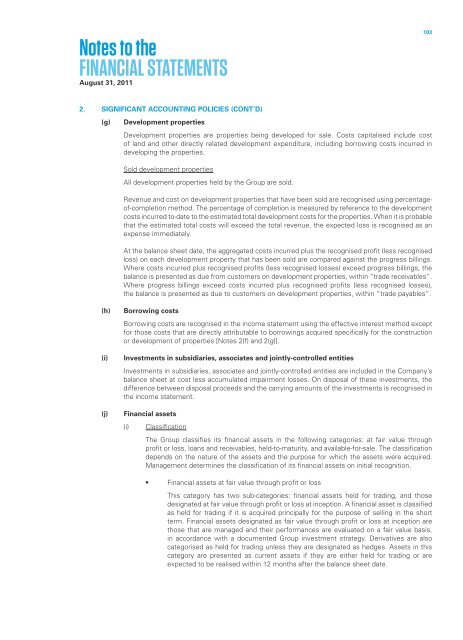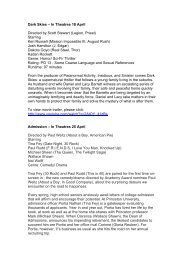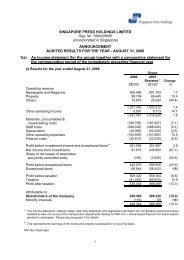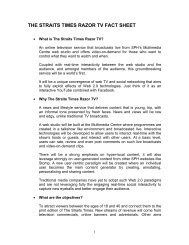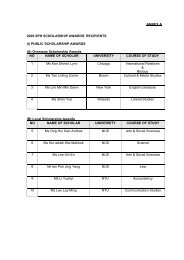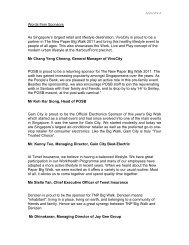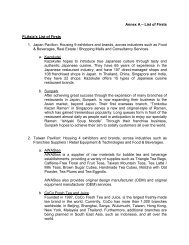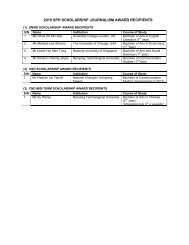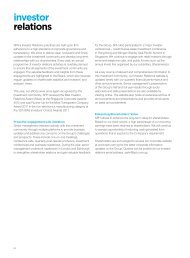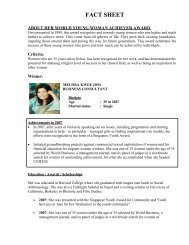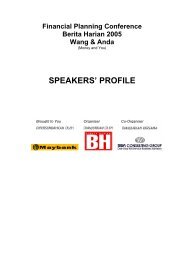Singapore Press Holdings annual report 2011 Singapore Press ...
Singapore Press Holdings annual report 2011 Singapore Press ...
Singapore Press Holdings annual report 2011 Singapore Press ...
Create successful ePaper yourself
Turn your PDF publications into a flip-book with our unique Google optimized e-Paper software.
Notes to the<br />
Financial StatementS<br />
August 31, <strong>2011</strong><br />
103<br />
2. SIGNIFICANT ACCOUNTING POLICIES (CONT’D)<br />
(g)<br />
Development properties<br />
Development properties are properties being developed for sale. Costs capitalised include cost<br />
of land and other directly related development expenditure, including borrowing costs incurred in<br />
developing the properties.<br />
Sold development properties<br />
All development properties held by the Group are sold.<br />
Revenue and cost on development properties that have been sold are recognised using percentageof-completion<br />
method. The percentage of completion is measured by reference to the development<br />
costs incurred to-date to the estimated total development costs for the properties. When it is probable<br />
that the estimated total costs will exceed the total revenue, the expected loss is recognised as an<br />
expense immediately.<br />
At the balance sheet date, the aggregated costs incurred plus the recognised profit (less recognised<br />
loss) on each development property that has been sold are compared against the progress billings.<br />
Where costs incurred plus recognised profits (less recognised losses) exceed progress billings, the<br />
balance is presented as due from customers on development properties, within “trade receivables”.<br />
Where progress billings exceed costs incurred plus recognised profits (less recognised losses),<br />
the balance is presented as due to customers on development properties, within “trade payables”.<br />
(h)<br />
(i)<br />
(j)<br />
Borrowing costs<br />
Borrowing costs are recognised in the income statement using the effective interest method except<br />
for those costs that are directly attributable to borrowings acquired specifically for the construction<br />
or development of properties [Notes 2(f) and 2(g)].<br />
Investments in subsidiaries, associates and jointly-controlled entities<br />
Investments in subsidiaries, associates and jointly-controlled entities are included in the Company’s<br />
balance sheet at cost less accumulated impairment losses. On disposal of these investments, the<br />
difference between disposal proceeds and the carrying amounts of the investments is recognised in<br />
the income statement.<br />
Financial assets<br />
(i)<br />
Classification<br />
The Group classifies its financial assets in the following categories: at fair value through<br />
profit or loss, loans and receivables, held-to-maturity, and available-for-sale. The classification<br />
depends on the nature of the assets and the purpose for which the assets were acquired.<br />
Management determines the classification of its financial assets on initial recognition.<br />
• Financial assets at fair value through profit or loss<br />
This category has two sub-categories: financial assets held for trading, and those<br />
designated at fair value through profit or loss at inception. A financial asset is classified<br />
as held for trading if it is acquired principally for the purpose of selling in the short<br />
term. Financial assets designated as fair value through profit or loss at inception are<br />
those that are managed and their performances are evaluated on a fair value basis,<br />
in accordance with a documented Group investment strategy. Derivatives are also<br />
categorised as held for trading unless they are designated as hedges. Assets in this<br />
category are presented as current assets if they are either held for trading or are<br />
expected to be realised within 12 months after the balance sheet date.


